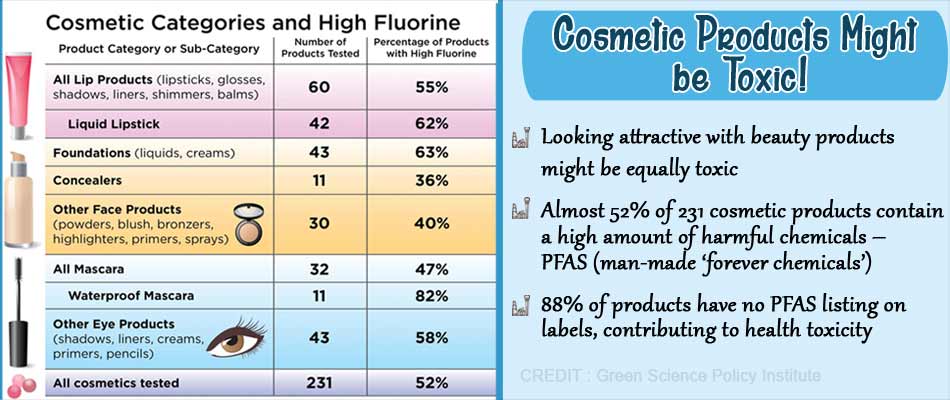(no scientific estimate of their half-life/ time taken for 50% of the chemical to disappear) and rather serve to bioaccumulate in bodies over time. This, in turn, contributes to certain
, and ecotoxicity.
These chemicals are present in almost every product we use in day-to-day life with many not even perceiving the danger of these products. Despite the removal of these products from the consumer industry, new versions tend to mount at every instance, devising the population at high risk.
According to a report by the US Centers for Disease Control and Prevention, these widespread chemical levels have been detected in the blood of 97% of Americans.
Cosmetics High in PFAS
Some of the highest levels of fluorine concentrations (a marker for PFAS) were found in more than half of long-lasting lipstick (62%), and eye products, more than three-quarters of waterproof mascara (82%), and two-thirds of foundations (63%), as per the data which was unexpected by the study team.
This poses an alarming danger because PFAS chemicals can be more readily absorbed by the “thin, delicate mucous membranes” close to the eyes and can even be ingested from lips which consequently upgrade the risks.
This marker is distinct from the inorganic fluorine which is added to drinking water. Among the tested products, an in-depth analysis was performed at an outside lab in the 29 product samples with the highest levels of fluorine. It was found that each of those 29 products contained at least four PFAS chemicals of concern.
“It’s a little shocking and hopefully a wake-up call for the cosmetics industry in terms of how widespread the PFAS contamination is across types of makeup products. The most common PFAS is polytetrafluoroethylene, the ingredient most commonly known as Teflon, or the coating on pans. But all in all, we have identified 13 different PFAS chemicals in more than 600 products from 80 brands,” says David Andrews, a senior scientist for the Environmental Working Group, or EWG, a consumer organization that maintains a database on personal care products which contain toxins. He was not involved in the study.
Intentional Transit
The PFAS are intentionally added to the beauty products to render a smooth, shiny, and consistent texture. The common names for PFAS include PTFE (polytetrafluoroethylene), perfluorooctyl triethoxysilane, perfluorononyl dimethicone, perfluorodecalin, and perfluorohexane
Another unintentional reason for these chemicals is not mentioned on the ingredient labels might be due to the raw material impurities or the breakdown of PFAS ingredients that produce other types of PFAS.
Say “No” to PFAS in Cosmetics – The Legal Action
This tremendous level of has contributed to the schedule of the “No PFAS in Cosmetics Act” bill to be launched in the US House and Senate by Republican Sen. Susan Collins of Maine and Democratic Sen. toxicity in cosmetics Debbie Dingell of Michigan.
“Americans should be able to trust that the products they are applying to their hair or skin are safe. To help protect people from further exposure to PFAS, our bill would require the FDA to ban the addition of PFAS to cosmetics products,” says Collins in a statement.
The rule to ban the intentional addition of PFAS in cosmetics shall be issued within 270 days of enactment by FDA, with a final rule to be issued 90 days thereafter. This new legislation anticipates reducing the toxic heavy metals in even baby food.
Other cosmetic alliances like the Personal Care Products Council (represent more than 90% of the U.S. beauty industry) and Cosmetics Alliance Canada awaits internal scientific review.
Retailers Concern!
Several retailers like Walmart, Target, Rite Aid, CVS, Walgreens, and Amazon, have presented a commitment to look for toxic chemicals in beauty products, including those marketed to women of color, skin lightening creams, hair straighteners, and relaxers, as per the 2021 ‘Who’s Minding the Store? A Report Card on Retailer Actions to Eliminate Toxic Chemicals’.
A collaborative effort of non-profit partner organizations that incorporates the environmental advocacy groups Toxic-Free Future, WE ACT for Environmental Justice and Defend Our Health has been involved in the contribution to the report.
The World Health Organization highlights the hazards of mercury in skin lightening creams and endocrine-disrupting chemicals in hair relaxers and other products that are marketed to women of color (who use more beauty products than other races). This drives to grave health concerns.
The beauty and personal care sector fetched some of the greatest gains to the companies as per the evaluation of the report card.
Recognizing Carcinogenic Compounds
Amidst the abundance of all these chemicals, it is important to find the carcinogenic chemicals toxic to humans. The International Agency for Research on Cancer (IARC) is an intergovernmental agency, and part of the World Health Organization that merges scientific evidence to classify these chemicals into five levels:
- Group 1: Carcinogenic to humans
- Group 2A: Probably carcinogenic to humans
- Group 2B: Possibly carcinogenic to humans
- Group 3: Not classifiable as to their carcinogenicity to humans
- Group 4: Probably not carcinogenic to humans.
Almost 11 agents out of 113 Group 1 listed agents have been or are currently utilized in personal care products.
Measures to Stay Alert!
With enormous and long-lasting impacts on health, these PFA chemicals add to the concern of the public. Following are certain stratagems that can be exerted to keep these chemicals out from daily life:
- Withdraw using any waterproof or long-lasting makeup products.
- Shopping for the label “organic” or “natural” alone may not provide safety to the makeup product. Hence it is
- Go for brands that are transparent about their supply chain and ethically guarantee safe ingredients.
- Avoid cosmetics and personal care products comprising some of the harmful chemicals like formaldehyde and formaldehyde-releasing preservatives (quaternium-15, diazolidinyl urea, imidazolidinyl urea, DMDM hydantoin, and 2-bromo-2-nitropropane-1,3 diol), phenacetin, coal tar, benzene, untreated or mildly treated mineral oils, ethylene oxide, chromium, cadmium, and its compounds, arsenic and crystalline silica (or quartz).
- Despite multiple tests, one may fail to appreciate the pitfall of PFAS chemicals in products. Utilizing the Skin Deep database on EWG’s site may guide in looking up safe products.
- Many other approved websites reveal the ingredients of harmful chemicals in products for safer selection.
References:
- Basic Information on PFAS – (https://www.epa.gov/pfas/basic-information-pfas)
- Carcinogens in Cosmetics – (https://www.safecosmetics.org/get-the-facts/chemicals-of-concern/known-carcinogens/)
- FDA Authority Over Cosmetics: How Cosmetics Are Not FDA-Approved, but Are FDA-Regulated- (https://www.fda.gov/cosmetics/cosmetics-laws-regulations/fda-authority-over-cosmetics-how-cosmetics-are-not-fda-approved-are-fda-regulated)
- How Safe Are Cosmetics and Personal Care Products?
– (https://www.urmc.rochester.edu/encyclopedia/content.aspx?contenttypeid=1&contentid=4498) - EWG’s Skin Deep – (https://www.ewg.org/skindeep/)
Source: Medindia



